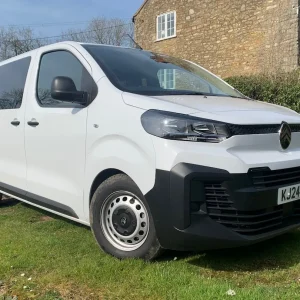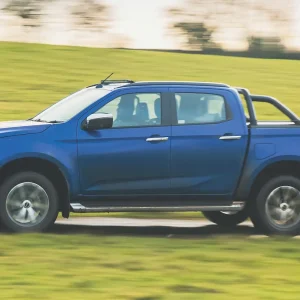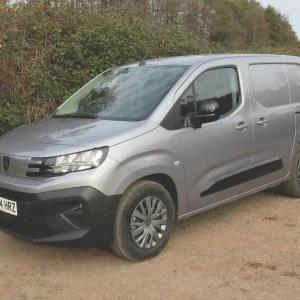Happily it’s a drawback that Mitsubishi has recognised, and it has done something about it. It has launched a Long Bed version that is now on sale alongside the standard model and gives owners an extra 180mm of load length to utilise. The wheelbase remains unchanged, as do the cab’s dimensions, but overall vehicle length is now 5,180mm.
We decided to check it out by sampling a four-door five-seater Double Cab in Animal trim. Long Bed can also be ordered in 4Work, 4Life and Warrior guise.
Technical
 Power comes courtesy of an upgraded version of L200’s 2.5-litre four-cylinder intercooled common rail diesel pumping out a hefty 175hp at 4,000rpm. Peak torque of 400Nm kicks in at a usefully-low 2,000rpm and the engine is married to a five-speed manual gearbox. The engine is used in the Warrior Long Bed too; the 4Work and 4Life take the more prosaic 134hp variant of the 2.5 lump.
Power comes courtesy of an upgraded version of L200’s 2.5-litre four-cylinder intercooled common rail diesel pumping out a hefty 175hp at 4,000rpm. Peak torque of 400Nm kicks in at a usefully-low 2,000rpm and the engine is married to a five-speed manual gearbox. The engine is used in the Warrior Long Bed too; the 4Work and 4Life take the more prosaic 134hp variant of the 2.5 lump.
Fully independent double wishbone suspension is fitted at the front while a rigid axle plus elliptic leaf springs help support the rear. Our Animal sat on 17in alloy wheels — they come as standard — shod with Bridgestone Dueler 245/65 R17 H/T tyres.
You’ll find ventilated disc brakes at the front and drums at the back and ABS and Electronic Brakeforce Distribution are standard. So is an active stability and traction control package. The power-assisted steering offers an 11.8m turning circle between kerbs.
Gross weight is 2,920kg and our test vehicle could tow a braked trailer grossing at 2,700kg. Top payload capacity is 1,045kg.
Load Area
 Access to the cargo bay is by means of a rear tailgate which you release by pulling on a centrally-mounted handle. The tailgate can be locked horizontally, or dropped down almost completely if you unhook the folding support arms on each side.
Access to the cargo bay is by means of a rear tailgate which you release by pulling on a centrally-mounted handle. The tailgate can be locked horizontally, or dropped down almost completely if you unhook the folding support arms on each side.
Equipped with tie-down points, the load box offers a maximum length of 1,505mm. Maximum width is 1,470mm narrowing to 1,085mm between the wheel boxes, while maximum sidewall height is 460mm. The sidewalls are slightly higher than the ones fitted to the standard model and have a more-horizontal upper edge. Rear loading height is 850mm and both the sides and the tailgate are double-walled.
Our demonstrator was fitted with a plastic load bed liner for an extra £210 plus a hard top finished in the same colour as the body for £1,248. All prices quoted here exclude VAT.
Cab Comfort
 Beauty is in the eye of the beholder and this writer found the blue instruments and switch gear that come with Animal trim a bit garish. Nor was he that enamoured of the, slightly tacky looking, blue stitching used on the leather-trimmed steering wheel, gearstick and seats.
Beauty is in the eye of the beholder and this writer found the blue instruments and switch gear that come with Animal trim a bit garish. Nor was he that enamoured of the, slightly tacky looking, blue stitching used on the leather-trimmed steering wheel, gearstick and seats.
These considerations of taste aside, our demonstrator turned out to be a pleasant vehicle to live with. We especially like the ability to lower the heated back window electrically. As well as giving you a bit more ventilation, it allows you to carry items that are a bit too long for the cargo bed by poking them into the cab.
Electric windows grace all four doors — the glass in the rear ones is tinted — and the exterior mirrors in their chrome casings are electrically heated and adjustable.
Climate control is fitted as standard as are a satellite navigation system, an MP3-compatible six-speaker stereo radio player with RDS and a 10-CD autochanger, a Bluetooth hands-free kit and driver and front passenger airbags. So is a display that includes a compass — handy if you’re doing some serious off-roading — a barometer and an altimeter.
Storage facilities include a lidded compartment between the seats, a 12v power point in the same location, a roomy, lockable glovebox and bins in the doors. You’ll find a couple of cup-holders between the seats and a slot above the windscreen for your sunglasses.
Good to see that the driver’s seat is height-adjustable, as is the steering wheel.
There’s seating for three in the back and we were delighted to see that all three occupants benefit from a headrest and a lap-and-diagonal belt.
Too many manufacturers seem to feel that a lap strap is all that the rear centre passenger in a double-cab needs, with no headrest. In our opinion such an approach is irresponsible given that he risks hitting the back of his head on the rear window if no headrest is provided and the driver has to brake heavily.
While all the rear passengers in an L200 enjoy more legroom than one might expect, unfortunately piggy-in-the-middle doesn’t get much shoulder-room. When he’s not present an armrest with a pair of cup-holders can be folded down for the two outboard passengers to use.
On the Road
 If you’re looking for a gutsy performer, then look no further. With plenty of torque exactly where it matters, this L200 has lots of low-down grunt. It’s not a bad performer on the motorway either — the standard cruise control helps — and the gearchange is smooth and user-friendly.
If you’re looking for a gutsy performer, then look no further. With plenty of torque exactly where it matters, this L200 has lots of low-down grunt. It’s not a bad performer on the motorway either — the standard cruise control helps — and the gearchange is smooth and user-friendly.
The handling of modern 4×4 pick-ups has improved remarkably when compared with the wallowing whales of yesteryear and L200 is no exception. While you should never forget that it’s got a higher centre of gravity than a low-slung sports car, you can push it quite hard through bends without coming unstuck; unless you do something really silly.
L200 is a lot more manoeuvrable than it appears to be on paper, and that proved a boon when we tried to negotiate some of Herefordshire’s narrower lanes and farm tracks.
Four-wheel drive is easy to engage — you use a short, stubby lever next to the gearstick — and the availability of both a high- and a low-ratio set of gears kept us out of trouble as we sloshed through the mud. Steep, slippery ascents and descents were negotiated with ease.
While engine noise isn’t an issue, tyre noise can be intrusive. The ride can be choppy when L200 is unladen, and things don’t improve too much with a 100kg test load in the back. Freight it up to the maximum and the suspension calms down, but few L200 owners drive their vehicles fully-laden all the time.
Something that definitely doesn’t help is the lack of a wide-angle section on the mirrors. A minor criticism, perhaps, but it is one that needs addressing.
As well as special internal and external logos, the Animal Double Cab is distinguished by running boards, chrome door handles, chrome-trimmed front and rear lights, a colour-keyed front bumper and colour-keyed wheelarch extensions. You get a front skid plate and front fog lamps too along with a chrome rear bar incorporating a step.
The new uprated version of the L200’s 2.5-litre engine acquits itself well when it comes to fuel consumption; in our hands it averaged 33mpg.
L200 requires servicing every 12,500 miles and is covered by a three year/100,000 mile warranty. Pan-European breakdown assistance is included for the duration and the vehicle is additionally protected by a 12 year anti corrosion perforation warranty.
This version falls into insurance group 9E and an alarm, an immobiliser and remote central locking are included in the price.
Verdict
The availability of a longer cargo bed makes Mitsubishi’s L200 Double Cab a far more useful workhorse. With the 175hp version of the 2.5-litre under the bonnet it has plenty of performance on tap and it handles a lot better than quite a few 4x4s we can think of. It goes about its business efficiently both on- and off-road, and is much more manoeuvrable than we expected it to be. On the downside the ride is poor at times, especially when the truck is lightly laden. Nor are we that keen on certain aspects of the Animal interior trim, although we fully appreciate that some buyers will love it to bits. All in all though, we like the L200 Double Cab Long Bed. We think you will too.

 While we’re huge fans of Mitsubishi’s L200 pick-up, we’ve always had to concede that it has one flaw. In double cab guise its load bed is a tad too short and that poses potential problems for anybody who wants to use it as a serious workhorse.
While we’re huge fans of Mitsubishi’s L200 pick-up, we’ve always had to concede that it has one flaw. In double cab guise its load bed is a tad too short and that poses potential problems for anybody who wants to use it as a serious workhorse.



